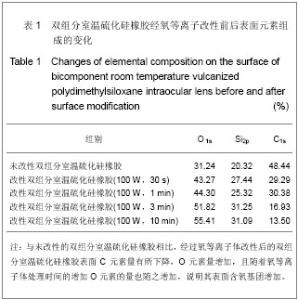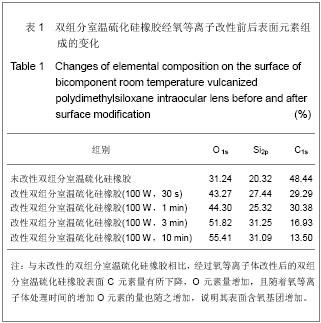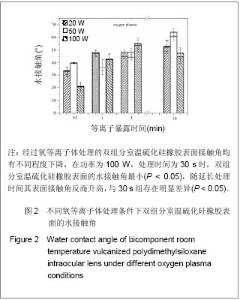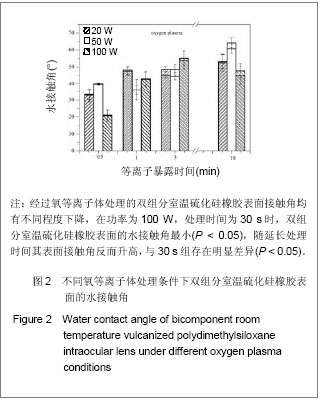Chinese Journal of Tissue Engineering Research
Previous Articles Next Articles
Biocompatibility of intraocular lens via oxygen plasma treatment
Xia Rui-jing, Xu Xu, Luo Li, Li Ling-li, Chen Hao
- Institute of Ophthalmology & Optometry, Wenzhou Medical College, Wenzhou 325027, Zhejiang Province, China
-
Received:2012-09-10Revised:2012-11-13Online:2013-05-21Published:2013-05-21 -
Contact:Li Ling-li, M.D., Assistant researcher, Institute of Ophthalmology & Optometry, Wenzhou Medical College, Wenzhou 325027, Zhejiang Province, China Chen Hao, M.D., Associate professor, Master’s supervisor, Institute of Ophthalmology & Optometry, Wenzhou Medical College, Wenzhou 325027, Zhejiang Province, China chenhao823@mail.eye.ac.cn -
About author:Xia Rui-jing, Institute of Ophthalmology & Optometry, Wenzhou Medical College, Wenzhou 325027, Zhejiang Province, China xiaruijing@126.com -
Supported by:Key Science and Technology Innovative Research Team of Zhejiang Province, No. 2011R09039-07; Wenzhou Municipal Science and Technology Bureau, No. Y20090245; Innovation Training Plan of Zhejiang Province for University Students (Xinmiao Talent Program 2011), No. 2010R413009
CLC Number:
Cite this article
Xia Rui-jing, Xu Xu, Luo Li, Li Ling-li, Chen Hao. Biocompatibility of intraocular lens via oxygen plasma treatment[J]. Chinese Journal of Tissue Engineering Research, doi: 10.3969/j.issn.2095-4344.2013.21.016.
share this article
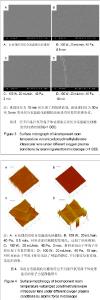
疏水性双组分室温硫化硅橡胶表面的原始水接触角是104°。从图2可以看出,经过氧等离子体处理的双组分室温硫化硅橡胶表面其接触角均有不同程度下降,在功率为100 W,处理时间为30 s时,双组分室温硫化硅橡胶表面的水接触角最小,为(20.62±3.44)°,根据统计结果,该值明显小于20 W的(38.82±4.53)°和50 W的(41.92±0.26)°;随着延长处理时间其表面水接触角反而升高,与30 s组存在明显差异。 2.3 氧等离子体处理双组分室温硫化硅橡胶表面形貌检测 为了考察经过氧等离子体处理后双组分室温硫化硅橡胶表面形貌变化,将处理前后的材料进行扫描电镜观察,结果见图3,从图上可看到处理时间为10 min,出现了刻蚀的痕迹,而处理时间为30 s和3 min的双组分室温硫化硅橡胶表面没有观察到明显的形貌变化。 经过氧等离子体处理得双组分室温硫化硅橡胶还进行了AFM检测,可进一步观察材料表面的形貌变化和粗糙度。从图4可以看到,未处理的双组分室温硫化硅橡胶表面平均粗糙度为微米级别,100 W,30 s处理后的双组分室温硫化硅橡胶表面形成了纳米级别的拓扑结构,而100 W,3 min和100 W,10 min均有不同程度的裂纹。"
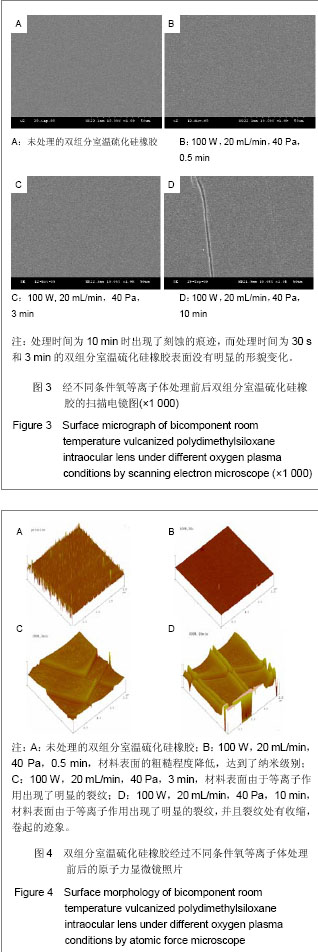
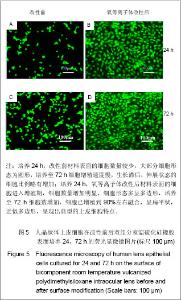
2.4 改性前后双组分室温硫化硅橡胶表面人晶状体上皮细胞吸附和增殖实验 将人晶状体上皮细胞种于处理前的双组分室温硫化硅橡胶与经过100 W,40 Pa,30 s氧等离子处理的双组分室温硫化硅橡胶材料,通过荧光显微镜结合FDA染色观察,由图5可知改性前后的双组分室温硫化硅橡胶表面均有人晶状体上皮细胞黏附,培养24 h,未处理组的细胞数量为(118±69)/mm2,大部分细胞形态为圆形,培养至72 h细胞数量为(248±78)/mm2,细胞增殖速度慢,生长滞后,伸展状态的细胞比例略有增加;氧等离子体处理组的细胞进入增殖期,细胞数量增加很明显,达到(536±81)/mm2,细胞形态多呈多边形,培养至72 h细胞数增加至(720±89)/mm2,细胞已增殖到90%左右融合,呈扁平状,近似多边形,呈现出典型的上皮细胞特点。"
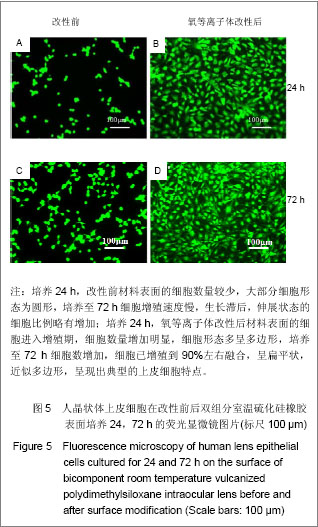
| [1] Wilson ME Jr,Trivedi RH. The on going battle against posterior capsula opacification. Arch Ophthalmol.2007;125(4):555-556.[2] Matai O,Schellini SA,Padovani CR.Cataract-operated individuals at the Center-Western zone of São Paulo state. Arq Bras Oftalmol.2008;1(1):52-56.[3] Brar GS,Grewal DS,Ram J,et al.Square-edge polymethylmethacrylate intraocular lens design for reducing posteriorcapsule opacification following paediatric cataract surgery: initial experience. Clin Experiment Ophthalmol. 2008; 36(7): 625-630.[4] Apple DJ,Peng Q,Visessook N,et al.Eradication of posterior capsule opacification: documentation of a marked decrease in Nd:YAG laser posterior capsulotomy rates noted in an analysis of 5416 pseudophakic human eyes obtained postmortem.Ophthalmology.2001;108(3): 505-518.[5] Burq MA,Taqui AM. Frequency of retinal detachment and other complications after neodymium: Yag laser capsulotomy. J Pak Med Assoc.2008;58(10): 550-552.[6] Unal M,Yücel I,Akar Y. Brinzolamide 1% versus apraclonidine 0.5% to prevent intraocular pressure elevation after neodymium:YAG laser posterior capsulotomy. J Cataract Refract Surg.2006;32(9):1499-1502.[7] Aslam TM,Devlin H,Dhillon B.Use of Nd:YAG laser capsulotomy.Surv Ophthalmol. 2003;48(6):594-612.[8] Yan Q,Perdue N,Sage EH.Differential responses of human lens epithelial cells to intraocular lenses in vitro: hydrophobic acrylic versus PMMA or silicone discs. Graefes Arch Clin Exp Ophthalmol.2005;243(12):1253-1262.[9] Holgeeson P,Sutherland DS,Kasemo B. Patterning and modification of PDMS surface through laser micromachining of silicon mastersand molding. Appl Phys A.2005;81: 51-56.[10] Pinto S,Alves P,Matos CM,et al.Poly(dimethyl siloxane) surface modification by low pressure plasma to improve its characteristics towards biomedical applications. Colloids Surf B Biointerfaces.2010;81(1):20-26.[11] Linyan Y,Li L,Qin T,et al.Photocatalyzed Surface Modification of Poly(dimethylsiloxane) with Polysaccharides and Assay of Their Protein Adsorption and Cytocompatibility. Anal Chem. 2010;82(15): 6430-6439.[12] Zhang Z,Wang J,Tu Q,et al.Surface modification of PDMS by surface-initiated atom transfer radical polymerization of water-soluble dendronized PEG methacrylate. Colloids Surf B Biointerfaces.2011;88(1): 85-92[13] Dou YH,Bao N,Xu JJ,et al.A dynamically modified microfluidic poly(dimethylsiloxane) chip with electrochemical detection for biological analysis.Electrophoresis.2002;23(20):3558-3566.[14] Alcantar NA,Aydil ES,Israelachvili JN.Polyethylene glycol-coated biocompatible surfaces. J Biomed Mater Res. 2000;51(3): 343-351.[15] Ginn BT,Steinbock O.Polymer Surface Modification Using Microwave Oven Generated Plasma. Langmuir.2003;19: 8117-8118.[16] Alenka V,Ita J,Uros C,et al.Surface modification of polyester by oxygen- and nitrogen-plasma treatment. Surface and Interface Analysis.2008;40(11):1444-1453. [17] Qu X,Cui W,Yang F,et al.The effect of oxygen plasma pretreatment and incubation in modified simulated body fluids on the formation of bone-like apatite on poly(lactide-co-glycolide) (70/30). Biomaterials. 2007;28(1): 9-18.[18] Wang H,Ji J,Zhang W,et al.Biocompatibility and bioactivity of plasma-treated biodegradable poly(butylene succinate). Acta Biomater. 2009;5(1):279-287.[19] Hasirci N,Endogan T,Vardar E,et al.Effect of oxygen plasma on surface properties and biocompatibility of PLGA films. Surf Interface Anal.2010;42(6-7):486-491.[20] Scarpa G,Idzko AL,Götz S,et al.Biocompatibility Studies of Functionalized Regioregular Poly(3-hexylthiophene) Layers for Sensing Applications. Macromol Biosci. 2010;10(4): 378-383. [21] Wang H,Kwok DT,Wang W,et al.Osteoblast behavior on polytetrafluoroethylene modified by long pulse, high frequency oxygen plasma immersion ion implantation. Biomaterials.2010;31(3):413-419.[22] Gracielle FA,Daniel CFS,Raquel GS,et al.Mesoporous silica SBA-16 nanoparticles: Synthesis, physicochemical characterization, release profile, and in vitro cytocompatibility studies.Micropor Mesopor Mat.2013;168(1):102-110.[23] Zhang C,Jin J,Zhao J,et al.Functionalized polypropylene non-woven fabric membrane with bovine serum albumin and its hemocompatibility enhancement. Colloids Surf B Biointerfaces. 2013;102(1):45-52.[24] Chu PK.Progress in direct-current plasma immersion ion implantation and recent applications of plasma immersion ion implantation and deposition. Surf Coatings Technol.2012,In Press,Corrected Proof[25] Martins A,Pinho ED,Faria S,et al.Surface Modification of Electrospun Polycaprolactone Nanofiber Meshes by Plasma Treatment to Enhance Biological Performance.Small.2009; 5(10): 1195-1206.[26] Beaulieu I, Geissler M, Mauzeroll J. Oxygen Plasma Treatment of Polystyrene and Zeonor: Substrates for Adhesion of Patterned Cells.Langmuir.2009; 25(12): 7169-7176.[27] El-Ali J,Sorger PK,Jensen KF.Cells on Chips. Nature.2006; 442: 403-411.[28] Khademhosseini A,Langer R,Borenstein J,et al.Microscale technologies for tissue engineering and biology. Proc Natl Acad Sci USA.2006;103: 2480-2487.[29] Yuen C,Williams R,Batterbury M,et al.Modification of the surface properties of a lens material to influence posterior capsular opacification. Clin Experiment Ophthalmol.2006; 34(6): 568-574. |
| [1] | Li Li, Ma Li. Immobilization of lactase on magnetic chitosan microspheres and its effect on enzymatic properties [J]. Chinese Journal of Tissue Engineering Research, 2021, 25(4): 576-581. |
| [2] | Li Xinping, Cui Qiuju, Zeng Shuguang, Ran Gaoying, Zhang Zhaoqiang, Liu Xianwen, Fang Wei, Xu Shuaimei. Effect of modification of β-tricalcium phosphate/chitosan hydrogel on growth and mineralization of dental pulp stem cells [J]. Chinese Journal of Tissue Engineering Research, 2021, 25(22): 3493-3499. |
| [3] | Liu Liyong, Zhou Lei. Research and development status and development trend of hydrogel in tissue engineering based on patent information [J]. Chinese Journal of Tissue Engineering Research, 2021, 25(22): 3527-3533. |
| [4] | He Lin, Wu Xi, He Song, Yang Sen. Hydrophilicity and cell adhesion of hydroxyapatite bioceramics after the coating of polydopamine [J]. Chinese Journal of Tissue Engineering Research, 2021, 25(22): 3540-3544. |
| [5] | Zhou Anqi, Tang Yufei, Wu Bingfeng, Xiang Lin. Designing of periosteum tissue engineering: combination of generality and individuality [J]. Chinese Journal of Tissue Engineering Research, 2021, 25(22): 3551-3557. |
| [6] | Lang Limin, He Sheng, Jiang Zengyu, Hu Yiyi, Zhang Zhixing, Liang Minqian. Application progress of conductive composite materials in the field of tissue engineering treatment of myocardial infarction [J]. Chinese Journal of Tissue Engineering Research, 2021, 25(22): 3584-3590. |
| [7] | Ma Qing, Shi Liyan, Huang Sixue, Zheng Zhangbowen, Zhang Aihua, Zhan Desong, Fu Jiale. Research status and prospect of zirconia ceramics in dental prosthesis [J]. Chinese Journal of Tissue Engineering Research, 2021, 25(22): 3597-3602. |
| [8] | Wen Zhijing, Gu Pengzhen, He Xijing, Li Jialiang, Wang Yibin, Wang Yiqun. Development of high molecular polymer polyetherketoneketone and its prospects in medical applications [J]. Chinese Journal of Tissue Engineering Research, 2021, 25(22): 3603-3608. |
| [9] | Chen Siyu, Li Yannan, Xie Liying, Liu Siqi, Fan Yurong, Fang Changxing, Zhang Xin, Quan Jiayu, Zuo Lin. Thermosensitive chitosan-collagen composite hydrogel loaded with basic fibroblast growth factor retards ventricular remodeling after myocardial infarction in mice [J]. Chinese Journal of Tissue Engineering Research, 2021, 25(16): 2472-2478. |
| [10] | Xie Jian, Su Jiansheng. Advantages and characteristics of electrospun aligned nanofibers as scaffolds for tissue engineering [J]. Chinese Journal of Tissue Engineering Research, 2021, 25(16): 2575-2581. |
| [11] | Ji Qi, Yu Zhengwen, Zhang Jian. Problems and trends of technique and clinical application of metallic biomaterials prepared by three-dimensional printing technology [J]. Chinese Journal of Tissue Engineering Research, 2021, 25(16): 2597-2604. |
| [12] | Li Yanle, Yue Xiaohua, Nie Zhen, Zhang Junwei, Li Zhaohui, Nie Weizhi, Jiang Hongjiang. Characteristics and application of bioabsorbable materials in orthopedics [J]. Chinese Journal of Tissue Engineering Research, 2021, 25(16): 2612-2617. |
| [13] | Qian Nannan, Zhang Qian, Yang Rui, Ao Jun, Zhang Tao. Mesenchymal stem cells in the treatment of spinal cord injury: cell therapy and combination of new drugs and biomaterials [J]. Chinese Journal of Tissue Engineering Research, 2021, 25(13): 2114-2120. |
| [14] | Jia Wei, Zhang Mandong, Chen Weiyi, Wang Chenyan, Guo Yuan. Effects of femoral prosthetic materials on artificial knee arthroplasty performance [J]. Chinese Journal of Tissue Engineering Research, 2021, 25(10): 1477-1481. |
| [15] | Wang Qian, Li Lu, Shu Jingyuan, Dong Zhiheng, Jin Youshi, Wang Qingshan. Micro-morphology and phase of zirconia-based nano-hydroxyapatite functional gradient biomaterials [J]. Chinese Journal of Tissue Engineering Research, 2021, 25(10): 1517-1521. |
| Viewed | ||||||
|
Full text |
|
|||||
|
Abstract |
|
|||||
